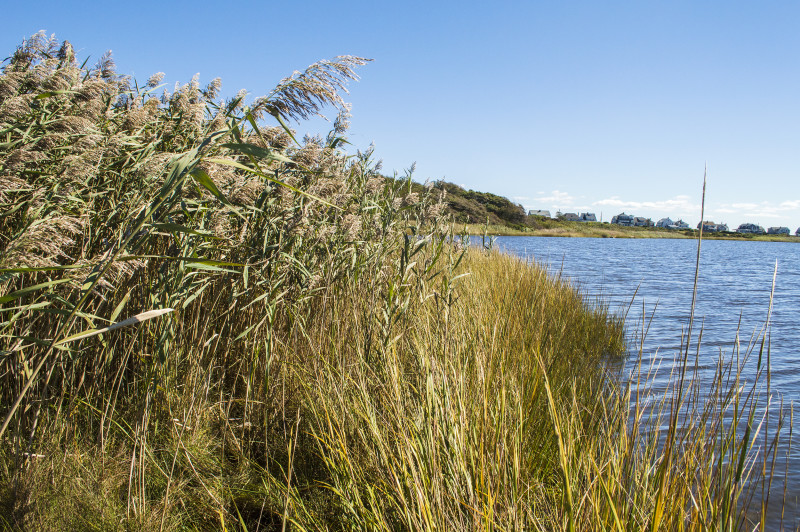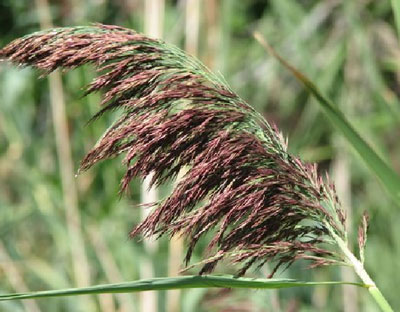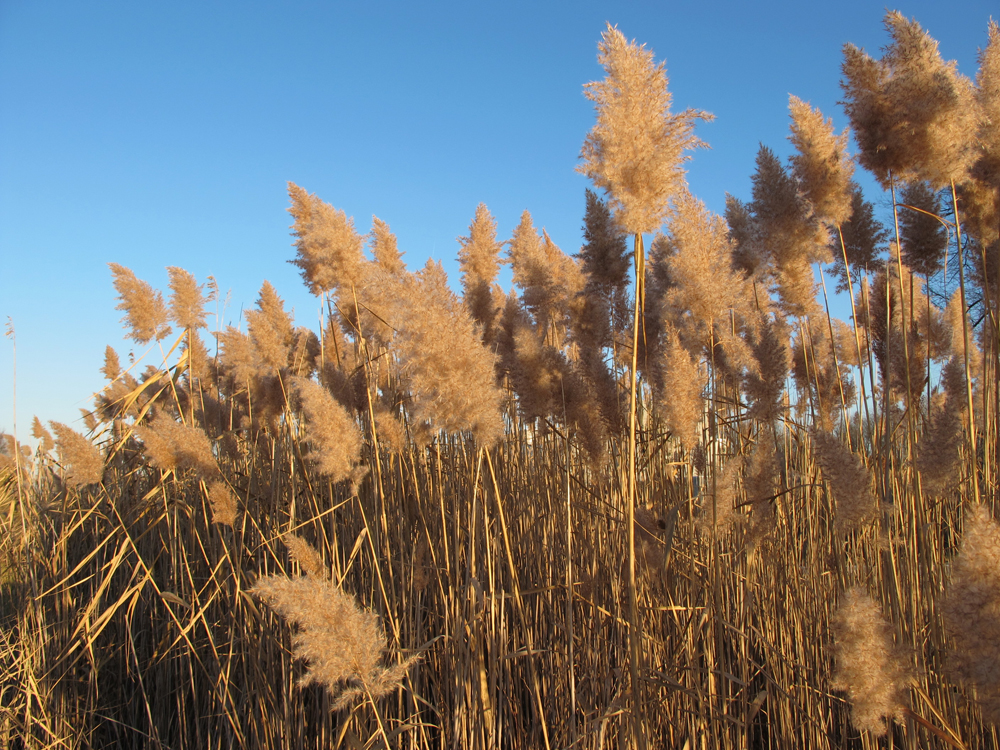Saginaw Bay Cooperative Invasive Species Management Area (SB-CISMA)
The SB-CISMA is a framework of collaborative communities working to cooperatively manage the environmental and economic impacts of these invasive species. With the help of our partners - public, private, and not-for-profit organizations. SB-CISMA fights invasive species by working with the public to identify, treat, and eradicate infestations. We provide education to the public on invasive species issues, and technical assistance for land managers to treat invasive species using economic and environmentally sound best practice management techniques.
Phragmites
While Phragmites control in these areas is a priority, there are no dates scheduled for treatment at this time.

Phragmites
Phragmites, Non-Native (Phragmites australis/Common Reed)
Non-native Phragmites, also known as common reed, is a perennial aggressive wetland grass that easily outcompetes native plants and displaces native animals. Due to its distinctive height, fluffy seed heads, and ability to grow in dense groups,Phragmites is easy to spot. Genetic studies have been done which confirm there is a variety of Phragmites along the Eastern Seaboard of the United States. However, native Phragmites has always been rare, doesn’t grow as densely, and blends in balance with natural vegetation. Today, invasive Phragmites is found across North America and dominates along the Atlantic coast where few native Phragmites populations remain. Non-native Phragmites, which is European in origin, first occurred in the eastern part of the United States in the early 19th century. The rapid spread of Phragmites was likely related to the construction of major roadways, railroads, habitat disturbance, shoreline development, pollution, and the process of eutrophication.

Why is non-native Phragmites an issue?
-
Recreational Impacts: Walking even a little ways into a stand of non-native Phragmites can be difficult because the growth can be exceptionally dense and tall, and the vegetation can be abrasive to your skin.
-
Visual Impacts: Phragmites can grow up to eighteen feet tall, obscuring views for landowners ,near by residents, and visitors.
-
Biological Impacts: Phragmitesoutcompetes and blocks out native vegetation and provides little to no food or shelter for most wildlife which normally thrive in these environments. Phragmites can also eliminate water channel and pool habitats which offer natural refuge and feeding grounds for invertebrates, fish, and water birds. Phragmites can create a dense jungle of vegetation that native species cannot penetrate. In addition, decomposing Phragmites can raise surface elevation, depriving wetlands and marshes of vital nutrients needed by native plants and animals for survival.

How does Phragmites spread?
- Phragmites can be spread by wind or animal-born seeds or by intentional introduction by people. Most commonly however, Phragmites spreads by horizontal above-ground stolons and underground rhizomes.
-
Stolons grow from an existing stem and are thin horizontalstructures that grow above ground, sprouting new plants. Rhizomes areunderground horizontal stems that also send out roots and shoots to start newplants. Stolons can grow dozens of feetannually, and new plants can sprout at nodes located every few inches along thestolon. Rhizomes, which create thick underground mats, can expand at the rateof around 30 feet per year, with new plants sprouting all along the rhizome.
These are a few of the issues which can make non-native Phragmites so difficult to deal with. EvenPhragmites which has been treated and appears dead is likely to have viableseeds and rhizomes. Once well established, Phragmites can be difficult tocontrol or eradicate. PRESS RELEASE -DNR,DEQ, MDARD to host outreach events at boat launches during Aquatic Invasive Species Awareness Week (June 29, 2016)
Gov. Rick Snyder has proclaimed July 3-9 as Aquatic Invasive Species Awareness Week in Michigan, and state departments are observing the week with outreach events at more than 50boat launches statewide. AIS are non-native aquatic plants and animals that disrupt the natural ecosystem, tourism and the economy. The week is highlighted by the third annual AIS Landing Blitz, an outreach event for boaters held at boat landings around the state. The DEQ is partnering with local volunteers as well as the Department of Natural Resources and Department of Agriculture and Rural Development to assist boaters in preventing the spread of these harmful species and complying with current AIS-related laws. With recent discoveries of invasive New Zealand mud snails in the Au Sable and Pere Marquette rivers, the week takes on an added importance. Many invasive species, including New Zealand mud snails, are easily spread by boaters and anglers using their equipment in multiple bodies of water without properly cleaning it. Anyone enjoying Michigan’s waters can take action to prevent the spread of aquatic invasive species by following these simple steps:
Required Actions – It’sthe Law in Michigan!
- Remove aquatic plants from boats, boating equipment and boat trailers before launching or placing in the water.
- Drain live wells, bilges and all water from boats before leaving the access site.
- Dispose of unused bait in the trash. Do not release bait into the water.
- Don’t transfer fish to water bodies other than where they were caught.
Recommended Actions –Protect Our Waters!
- Inspect and remove plants and mud from boats and trailers and dry equipment before leaving the access area. Dispose of the material in a trash receptacle or otherwise away from the water body if possible.
- Wash boats and trailers before leaving the access area if possible, or at a nearby car wash or at home.
- Dry boats and equipment for at least five days before launching into a different body of water.
- Disinfect live wells and bilges with bleach solution of 1/2 cup bleach to 5 gallons of water.
The Great Lakes and Michigan’s inland waters draw millions of recreational users and tourists annually, and already face negative impacts from numerous aquatic invasive species.Preventing the introduction of further invasive species is a responsibility for everyone who uses these resources. Events at boat launches are contingent on weather and local volunteer availability. For an up-to-date list of events, contact Kevin Walters at517-284-5473 or [email protected]. AIS Awareness Week is sponsored by the DEQ’s Water Resources Division with collaborative efforts from other state and federal agencies as well as private and nonprofit organizations. For more information about AIS Awareness Week, the AIS Landing Blitz, or to view the Governor’s proclamation, visit Michigan’s invasive species website at Michigan.gov/invasives.
Phragmites Information of Interest
2018 Proposed Phragmites Treatment along Saginaw Bay Shoreline
Treatments to control infestations of the invasive weed Phragmites may be done between August 25, 2018 and December 31, 2018 along the Saginaw Bay shoreline in Bay County. Weather conditions favorable for the treatment will dictate the exact date and time of treatment. Land based treatments will be done by Wildlife& Wetlands Solutions, 4371 N Long Lake Road, Traverse City, MI 49648 . The treatment areas are located along the Saginaw Bay near shore areas in Pinconning and Hampton Townships of Bay County, Michigan and the Property Owners in the spray areas have been notified. Phragmites Chemical treatment will be done with a mixture of the products Aqua Neat and Habitat which are aquatic formulations with the active ingredient pesticides Glyphosate and Imazapyr. These are non-selective herbicides that can cause damage to any plant that they contact. People and pets should avoid contact with the treated areas until spray solution has dried(approximately 6 hours) to prevent transfer of the spray product onto desirable vegetation. Surface water in treatment areas should not be used for irrigation for at least 24 hours after treatment. Mowing of dead Phragmites will also be done two or more weeks following chemical treatments using a Marsh Master.
This project was funded in part by the Michigan Invasive Species Grant Program. Any questions should be directed to Laura Ogar, of the Bay County Environmental Affairs and Community Development Department at 989-895-4135 or via email at [email protected].Landowner Authorization Form
Landowners in proposed areas must complete and sign a Landowner Authorization Form to allow Bay County to provide Phragmites Treatment to this area.
Maps of the Treatment Areas
Maps of treatment areas and labels of the spray products to be used may be viewed by clicking the links below, or at the Bay County Environmental Affairs & Community Development Department located on the 5th floor of the Bay County Building located at 515 Center Avenue, Bay City, Michigan 48708.
Maps of the Treatment Area - Hampton Townnship - Knodt Road Maps of the Treatment Area - Hampton Township - Meilan RoadMaps of the Treatment Area - Pinconning Township - Wirbel Road
Spray Product Label - AgguaNeat LabelMaterial Safety Data Sheet (MSDS) - AgguaNeat MSDS
Spray Product Label - Cygnet Plus LabelMaterial Safety Data Sheet (MSDS) - Cygnet Plus MSDS
Spray Product Label - Habitat LabelMaterial Safety Data Sheet (MSDS) - Habitat MSDS
This project was funded in part by the Michigan Invasive Species Grant Program. Any questions should be directed to Laura Ogar, of the Bay County Environmental Affairs and Community Development Department at 989-895-4135 or via email at [email protected].